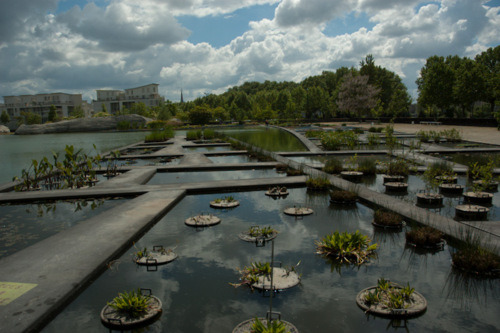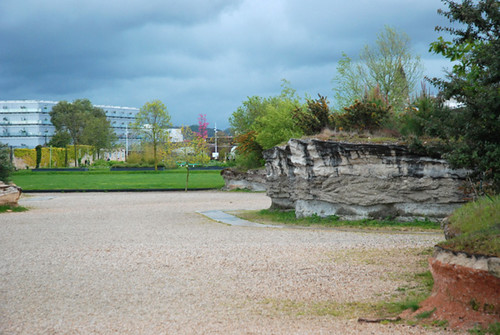Restriction and Release
By Sarah Wilson
A study of the methods of movement through a promenade
 |
| Jardin aquatique |
What better to examine in a promenade garden than its
namesake? A ‘promenade’, defined as both a leisurely walk and an opening dance
in a ball, is chiefly concerned with movement. The well-known Jardin Botanique
of Bordeaux was created in 2002 by landscape architect Catherine Mosbach and Françoise-Hélène
Jourda. This piece of landscape is classified as a promenade for its
organization of various sequentially connected gardens. The method of movement
between these botanical areas takes a few different forms, which are created
from the conversation between restriction and release. One or both of these
functions appears in the movement within and between each of the gardens, but
perhaps appears best in the first three gardens: the jardin aquatique, the
galerie des milieux, and the champ de cultures.
The
jardin aquatique’s organization is a series of small square ponds arranged
around one side of a larger water garden. The stone path zigzags its way around
each piece of these gardens. The path from the first gate to this water garden
is much wider, encompasses the span of the water garden, and it made of gravel.
This transition from wide to narrow, from loose rock to compact stone, marks a
change in movement. Guests feel this change as they are filtered, like the
water through the jardin aquatique, from the wide and free to the narrow and
confined as they wind their way through. After restricting themselves in their own erratic path,
they are released into a more open space, a transition point between the jardin
aquatique and the next garden.
 |
| Galerie des milieux |
From
here, there is a very noticeable change in movement and spatial experience. This
next aforementioned garden is the galerie des milieux, in which there are
several landscapes in miniature, elevated in their own islands above the ground
plane. Widely spaced apart with only a suggestion of a central path, these landscape
islands provide obstacles similar to the small square water gardens: both offer
points of visual interest while asking guests to find their way around them.
The difference, however, is in how controlled that round-a-bout path is. In the
galerie des milieux, the path is widely spaced and thus gives the inclination
to slow down or even pause for a conversation; this is not dissimilar to a
trail through the woods or a grassy plain, where a path may meander but does
not demand a pace. On the other hand, the jardin aquatic’s narrow suggests a
quicker, more precise passage. After the last landscape island there is another
transition space, though larger and more defined in shape. What follows is
another change in movement.
 |
| Champ de cultures |
The
champ de cultures garden is essentially a series of agricultural fields,
arranged in rows of long rectangles with grassy spaces for passage in between.
At the head of each field is a small raised viewing platform. The paths between
these fields are defined by long white stones spaced loosely apart, their
lengths running along the long sides of the fields. While there is some freedom
of movement, this garden suggests a much more streamlined and path. Once a guest
chooses an aisle to walk down, their chances of switching aisles are somewhat restricted. This is in great contrast to the first two gardens where the
paths where much more meandering, however fast or slow. Though the pace of the
third garden is ambiguous, it is highly suggestive of a straight path, and
therefore more controlled. However, this appropriately mimics the streamlined
and controlled environment defined by an agricultural field.
Mosbach
seems to have had in mind the character of each of her individual gardens when
she was designing the method of movement within and without each of these. The
range between narrow, meandering, wide, and streamlined reflects the nature of
the filtering water gardens, the landscape islands, and the efficient fields.
A change and flow of movement is paramount in a promenade garden, and even in
the first three pieces alone, it is clear that the Jardin Botanique of Bordeaux
lives up to its classification as a promenade.
No comments:
Post a Comment